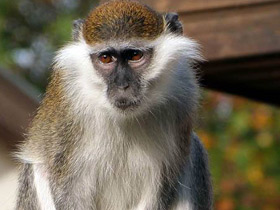The grivet (Chlorocebus aethiops)
The grivet (Chlorocebus aethiops) is an Old World monkey with long white tufts of hair along the sides of its face. Some authorities consider this and all of the members of the genus Chlorocebus to be a single species, Cercopithecus aethiops. As here defined, the grivet is restricted to Ethiopia, Sudan, Djibouti, and Eritrea. In the southern part of its range, it comes into contact with the closely related vervet monkey (Cercopithecus pygerythrus) and Bale Mountains vervet (Cercopithecus djamdjamensis). Hybridization between them is possible, and may present a threat to the vulnerable Bale Mountains vervet. Unlike that species, the grivet is common and rated as least concern by the IUCN.
Habitat
Chlorocebus aethiops is a species of catarrhine primate in the family Cercopithecidae. Chlorocebus aethiops is one of six species in the genus of green monkeys. It is common in the sparse forests and savannahs of Sudan east of the White Nile, in Eritrea and Ethiopia east of the Great Rift Valley and in Djibouti. These monkeys usually settle near water sources, but are able to adapt to different biotopes.
Appearance
The skin of the face, palms and feet of Chlorocebus aethiops is black. Above the eyes is a white stripe. The face is framed by long sideburns. The fur is olive-grey on the back, white on the belly and chest. The belly fur has a bluish tinge. This monkey has a body length of 50 cm in males and 43 cm in females, a tail length of 30 to 50 cm and a weight ranging from 3.4 to 8 kg, with males being heavier than females.
Lifestyle and nutrition
Unlike many other monkeys, Chlorocebus aethiops spends most of its time on the ground, although it sleeps in trees. They feed on the ground; however, these omnivorous primates feed on fruits, leaves, insects, small mammals and birds. It is not uncommon for them to forage in rubbish dumps. Chlorocebus aethiops consume a lot of water, especially during the dry season. They live in groups of between 5 and 70 individuals. Both sexes have a clear hierarchy in the group. There are also groups consisting only of males.
Reproduction
Females mate with a limited number of partners, while males try to mate with as many females as possible. Pregnancy in Chlorocebus aethiops lasts 2 to 3 months and usually results in the birth of a young. Newborns have pink skin and black fur, and after two months adopt adult colours. The mother feeds her young with milk until they are six months old. The lifespan of these monkeys is up to 13 years.
Relationship with humans
The grivet is one of five species of monkeys known to have been kept in ancient Egypt, the others being the hamadryas baboon, the olive baboon, the patas monkey, and the barbary macaque. Grivets were imported from the Land of Punt, as attested in paintings and in the Tale of the Shipwrecked Sailor. They were sometimes traded as far afield as Assyria. They are rarer in representations than baboons, and unlike baboons, do not seem to have borne individual names.
Grivets are depicted on Egyptian tombs as house pets and on leashes. In some depictions, they may symbolize male sexuality. Early Dynastic statuettes of grivets have been found in sanctuaries, where they may have been votive offerings to the baboon god. A grivet shooting a bow was an aspect of the invisible god Atum, and at Deltaic Babylon, a grivet was the town god represented by a statue in the temple.
Since the 1960s, the grivet has been harvested on an industrial scale by humans for their kidneys, which are used in poliovirus and adenovirus vaccine production. In 1967, the Marburg virus in grivets caused the death of 31 vaccine manufacturers.In the medical literature, the grivet and the green monkey are often confused. They are also used in medical research such as the testing of dengue vaccines as well as in the testing of human cosmetics.
Conservation
Grivets are occasionally hunted as bushmeat. They are killed for either commercial or subsistence purposes. Although not endangered, they are threatened through destruction of habitat - forests. They are preyed on by large snakes, leopards, humans, and sometimes baboons. Grivets may live for 13 years.












































